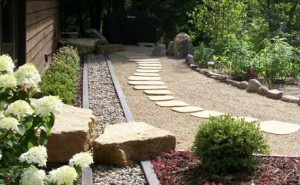Japanese Gardens – Shoe Removal Stones
 March 21, 2012
March 21, 2012
The shoe removal stone, or kustu-nugi-ishi, literally is the stone you stand on when removing your shoes before entering a Japanese home. These stones are generally found in the foyer of the home or adjacent to an engawa, or veranda, where you access the garden from the home. The shoe removal stone also delineates where shoes are worn and not worn. When standing on the stone removing your shoes you should do so making sure you do not step out of your shoes onto the stone, but onto the veranda.
Shoe stones make an excellent functional and aesthetic choice for steps entering into a garden area. Deck style steps can also look nice, but natural stone is often a very fitting material. When selecting a shoe stone you should do so by understanding that it should be accompanied with a companion stone and at least one stepping stone, or tobi-ishi. The Shoe stone is the largest and is the one located immediately adjacent to the area of the home where you would remove your shoes; this is often within the foyer or engawa. In our projects here in the United States this stone would be set next to a veranda, deck or a door entering a home. Kutsu-nugi-ishi also works beautifully when combined with a stepping stone pathway flowing seamlessly from the path to decks and homes.
Shoe stones also make comfortable footrests, or a place to sit. A nice dark colored granite boulder with a flat top makes a nice shoe. However, find one with the right size width, length and height can sometimes be difficult. Although not dark and as dense as granite, we have often used limestone, which is more easily found with the appropriate dimensions. We have also developed a nice mix of materials where the use of limestone has actually worked out quite nicely. These specimen shoe stones fit right into our projects, adding a touch of and style of a Japanese garden and a beautiful artistic element.
The picture above shows one of our projects where we have a tobi-ishi stepping stone pathway connecting to the primary entrance from the house to the garden. We did not connect the stepping stones to the smaller shoe stone in the foreground, because this door leads to the master bedroom. Thus, the stepping stone pathway is used to create stronger visual connection to the primary door while providing smooth stones which are more comfortable to walk on, especially when barefoot. The gravel area allows for additional circulation with easy access to and from the master bedroom shoe stone and door.
If you would like our help with your stonework or Japanese garden project, contact us, Niwa Design Studio, at 952-470-1882.
You can also visit Japanese Garden Journal for more information about Japanese Gardens.

 Posted in
Posted in  content rss
content rss